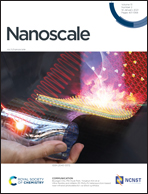Doping controlled Fano resonance in bilayer 1T′-ReS2: Raman experiments and first-principles theoretical analysis†
Abstract
In the bilayer ReS2 channel of a field-effect transistor (FET), we demonstrate using Raman spectroscopy that electron doping (n) results in softening of frequency and broadening of linewidth for the in-plane vibrational modes, leaving the out-of-plane vibrational modes unaffected. The largest change is observed for the in-plane Raman mode at ∼151 cm−1, which also shows doping induced Fano resonance with the Fano parameter 1/q = −0.17 at a doping concentration of ∼3.7 × 1013 cm−2. A quantitative understanding of our results is provided by first-principles density functional theory (DFT), showing that the electron–phonon coupling (EPC) of in-plane modes is stronger than that of out-of-plane modes, and its variation with doping is independent of the layer stacking. The origin of large EPC is traced to 1T to 1T′ structural phase transition of ReS2 involving in-plane displacement of atoms whose instability is driven by the nested Fermi surface of the 1T structure. Results are compared with those of the isostructural trilayer ReSe2.



 Please wait while we load your content...
Please wait while we load your content...